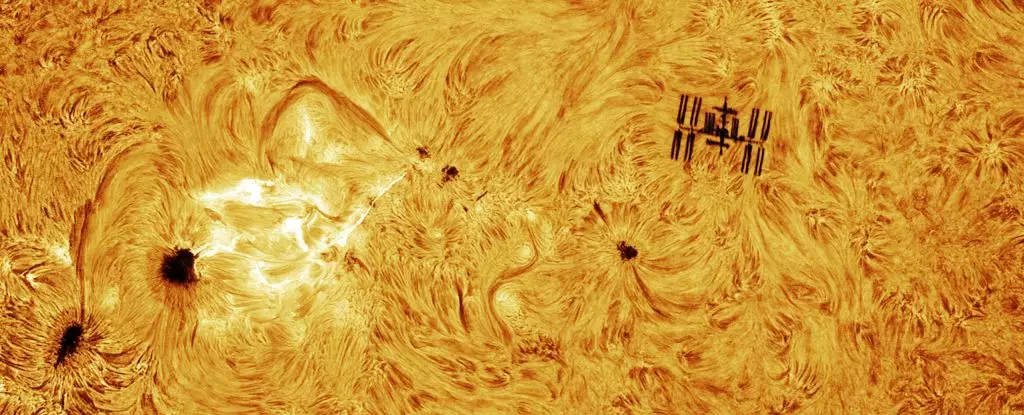Photographing the International Space Station (ISS) as it transits the Sun or Moon represents a pinnacle challenge for astrophotographers worldwide, requiring keen timing, precision, and a touch of serendipity. Yet, Arizona-based astrophotographer Andrew McCarthy elevated this already difficult feat to extraordinary heights. While setting up his equipment under the vast expanse of the Sonoran Desert, McCarthy did not merely capture the ISS slipping across the solar disc; he also immortalized a fleeting solar flare erupting in the Sun’s atmosphere. This simultaneous capture of an artificial marvel and a natural spectacle offers a dramatic visual narrative of mankind’s place amid cosmic forces.
This remarkable image, dubbed *Kardashev Dreams*, transcends the typical “space station silhouette” shot and delves into conceptual territory. It links the raw elemental radiance of the Sun’s chromosphere with humanity’s burgeoning technological prowess symbolized by the orbiting ISS. More than just a photograph, it challenges viewers to consider what it means to be a civilization on the verge of the stars, echoing the themes of the Kardashev Scale — a hierarchy that measures a society’s technological advancement by energy harnessing capacity.
Beyond a Simple Snapshot: Technical Mastery in Harsh Environments
McCarthy’s success is no accident. Astrophotography demands far more than simply pointing a camera skyward. His process involved capturing tens of thousands of individual solar images, then leveraging sophisticated computational stacking techniques to produce a composite of unparalleled detail and clarity. The intricacy of this method reveals previously unseen textural and dynamic nuances on the Sun’s surface, which ordinarily elude even professional observatories.
Moreover, the extreme environment of the Sonoran Desert posed obstacles that McCarthy overcame with ingenuity. To prevent his telescopes and sensitive equipment from overheating under intense desert sun, he ingeniously used ice packs and coolers, demonstrating how environmental adaptation is as vital in space photography as technological expertise. His dedication to both art and science underscores the blend of creativity and discipline required to push astrophotography into new frontiers.
The Subtle Drama of Solar Phenomena and Human Achievement
Solar flares, like the one captured in McCarthy’s image, are transient but potent outbursts of electromagnetic radiation originating from the Sun’s magnetic energy. They are unpredictable and short-lived, often lasting mere minutes, yet their implications are profound for space-based technology and astronaut safety. Although the ISS orbits safely thousands of kilometers closer to Earth than the Sun’s fiery surface—which means it was not in direct danger from the flare—the event spotlights the vulnerability of human-made machines operating in the cosmic environment.
The juxtaposition of the ISS—a symbol of steady, deliberate human exploration—with the volatile solar flare serves as a metaphor for humanity’s tenuous foothold in space. Our orbital outpost, while advanced, exists under the constant influence of solar weather phenomena that can disrupt communications and pose radiation risks. This tension between human control and natural power is a central theme embedded within *Kardashev Dreams*, inviting reflection on the delicate balance required as we expand our extraterrestrial presence.
Envisioning Future Civilizations Through Lens and Light
McCarthy’s intentional use of compositing elements from the 2024 solar eclipse to deepen the image’s black background helps narrate the story of solar activity and human observation in a single frame. It symbolically bridges moments in time—past, present, and aspirational future instances of celestial engagement. By naming his photo after Nikolai Kardashev, McCarthy ties this present glimpse of human achievement to a long-standing scientific contemplation about the potential destiny of civilizations.
From this perspective, the image does more than celebrate photographic skill or a lucky capture; it becomes a beacon of optimism and possibility. It reaffirms that the first steps—be it snapping a split-second transit or assembling orbiting laboratories—are fundamental markers on the path toward a civilization that commands its star system rather than being at its mercy.
For those inspired to attempt a similar celestial pursuit, tools like Transit Finder offer the chance to anticipate when these fleeting ISS transits will occur. Yet, as McCarthy’s work illustrates, capturing something truly transcendent requires more than technology; it demands patience, passion, and a profound reverence for the ephemeral beauty of our solar environment.

